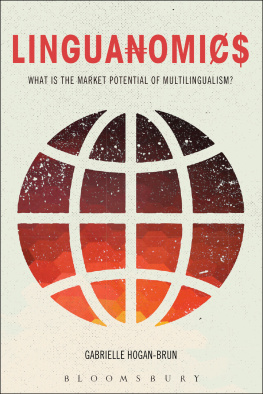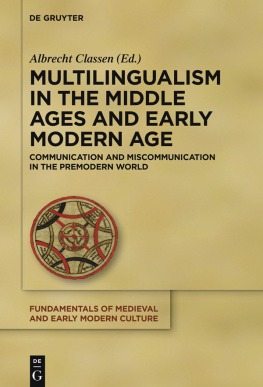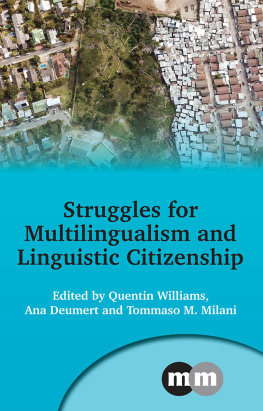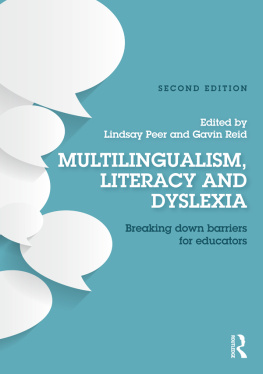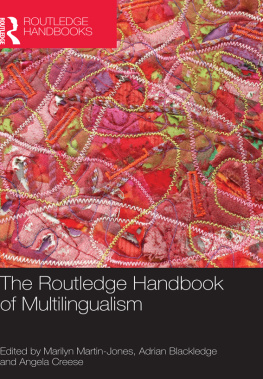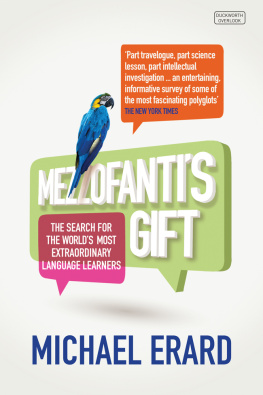Linguanomics
Also available from Bloomsbury:
Multilingualism: A Critical Perspective , Adrian Blackledge and Angela Creese
Multilingualism: Understanding Linguistic Diversity , John Edwards
Multilingual Encounters in Europes Institutional Spaces , edited by Johann W. Unger, Michal Krzyzanowski and Ruth Wodak
Why Do Linguistics? , Fiona English and Tim Marr
Other Books by Gabrielle Hogan-Brun:
Discourses on Language and Integration: Critical Perspectives on Language Testing Regimes in Europe (ed. with Clare Mar-Molinero and Patrick Stevenson)
Language Policies and Practices in the Baltic States (with Uldis Ozolins, Meilut Ramonien and Mart Rannut)
Minority Languages in Europe: Frameworks Status Prospects (ed. with Stephan Wolff)
National Varieties of German outside Germany. A European Perspective (ed.)
For John
Linguanomics
What is the Market Potential of Multilingualism?
Gabrielle Hogan-Brun
Bloomsbury Academic
An imprint of Bloomsbury Publishing Plc

Contents
With thanks to: Bill Dale, Justin Dillon, Yoshiko Fujita, Richard Green, Terry Jones, Gurdeep Mattu, Mary Morris, Tony Morris, Valerio Rinaldi, Mary Stoate, Claire Thomson, The Hogans, especially Christopher, Sarah, Patrick and John.
Polyglots, or at least bilinguals, wanted
You may have come across claims that language skills shortages harm the economy. But what are the facts? Consider the following statement:
One in four UK and one in six US businesses [is] losing out due to lack of language skills and cultural awareness in their workforce.
Corporations with international ambitions need multilingual employees to sell their goods and services. Many other organizations also require among their workforce people skilled in at least one non-native language. This need is reflected in todays hiring strategies. For example, the London Metropolitan Police is looking for bilingual recruits capable of forming a rapport with the citys diverse citizens to help boost confidence, solve crime more effectively and support victims and witnesses. The languages sought after range from Arabic and Punjabi to Yoruba.
Following the introduction of the additional language eligibility criteria as a key skill to become a police constable in the Met, you must now be able to speak one of 25 languages to be eligible to apply. Unless you meet our eligibility criteria, you will be unable to submit an application at this time.
Across the Atlantic, the US military requires officers who are proficient in languages critical to their national security currently Arabic, Chinese, Hindi, Indonesian, Korean, Persian, Portuguese, Russian, Swahili, Turkish and Urdu.
Entitlement to Foreign Language Proficiency Pay is established for officers and enlisted members receiving basic pay and certified by the individual service secretary to be proficient in a foreign language or dialect.
This initiative is generating new career paths as in the case of one student at the Portland State University Russian Flagship Program, who says: I am pursuing dual degrees in Russian and Architecture and plan to use my professional-level fluency to work as an architect for the US Army Corps of Engineers collaborating on projects with Russian speaking nations.
As these vignettes show, multilingual skills are valued by some employers and are economically favourable. But in the public sector, dealing with multilingualism is more often associated with costs. Financial constraints might mean that justice is more difficult to arrive at and that medical conditions are more difficult to diagnose. In severe cases, there might be miscarriages of justice, or misdiagnoses. This social dimension forms part of the pay-off when considering the costs and benefits of language diversity. Here too, multilingual individuals have a vital role to play.
On multilingualism
Multilingualism means different things in different places. It is estimated that half of the worlds population is bilingual or multilingual. There are 6,0007,000 languages in the world today, currently spread over just 196 countries. In many regions across the globe, a citizens ability to speak multiple languages is therefore normal and quite unremarkable and is an instrumental response to mundane needswithin their own family and possibly a third when buying and selling. They might not speak the languages they know equally well but will try to make themselves understood to get what they need. Among such language-rich territories are Papua New Guinea, Nigeria, India and South Africa.
But multilingual practice is not just a characteristic of a rainbow nation. In the largely homogenized Western world, cultures are being brought together at an unprecedented rate through social mobility. Cheap air travel has encouraged tourism on a massive scale and migration has become easier for some. In addition, the Web is an open gateway for the exchange of information across the globe. In short, multilingualism is playing more of a role in many Western societies. But it has always existed and likely will continue to do so. As we shall see, our ancestors utilized it: first to help them survive, then to barter and to prosper. They learnt and created languages, too, as they traded across distances. All the time, their business and language practices went hand in hand. With todays growing language needs, the challenge is to understand and unearth the economic and social benefits of multilingualism.
In fact, we do not have to look very far. Many schools, organizations and cities feature various types of multilingualism. In some countries, for example Luxembourg and Switzerland, it is officially supported. What is more, economists have even studied exactly how much citizens can benefit from speaking more than one language. Since multilingualism has been found to be rewarding at both the personal and national levels, it has been exploited in both countries. But the picture is not all rosy. Too much multilingualism is not cost-effective; there is a sweet spot that lies somewhere between using only one language and using too many. In addition, as we shall see, there is clear evidence that deals can be missed and, in worst case scenarios, peoples lives can be lost if multilingualism is not managed within the larger framework of multicultural understanding. So learning another language makes economic sense and will ultimately benefit individuals and society alike. It is already a practice across much of the European Union (EU), where children are taught two languages (in addition to their own) from an early age.
On Linguanomics
BBC News Wales reported (on 7 November 2014) that staff at Lidl supermarkets are being stopped from speaking any language other than English in their UK stores including Welsh. The store said it was to ensure that all their staff and customers felt comfortable.
This story encapsulates the central message of this book. It shows that languages have market value and that language skills should be seen as assets. But the utility of a particular language tends to be linked to the number of speakers. This is why Lidls managers considered English as more valuable than Welsh in their shops. However, this decision could have cost them the loyalty of their Welsh-speaking customers. As we shall see, this scenario is reflected on an international scale where corporations need to balance their language choices between global and local market forces.
Linguanomics has grown from my conviction that society can benefit from language diversity. It reflects insights from my own language trajectories and from my work on language planning and policy matters across the EU. I have always been driven by an understanding that multilingualism forms part of wider socio-political and economic issues and tensions therein. Here I lay out the facts for readers to make up their own minds about the interconnections of multilingualism and economics today.

